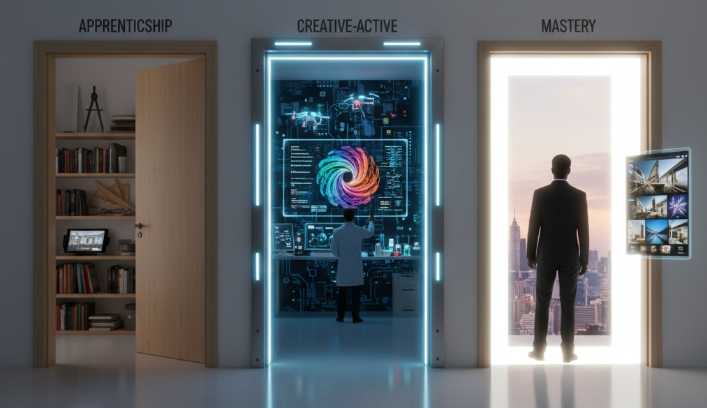Over the past twenty-plus years, I have mentored countless entrepreneurs. Some have found their footing quickly, while others struggled; however, the most successful followed a predictable path. Robert Greene captures this arc in his book Mastery. He describes three stages: Apprenticeship, Creative Active, and finally Mastery, which capture the path of business success.
To illustrate these stages, I occasionally share the story of “Maya” with my clients. Maya is not a real person. She is a composite made up of several clients I have worked with who started with strong technical skills but lacked a clear understanding of how to run a business. In this example, Maya represents a photographer who had been working for an agency, specializing in wedding and sports photography. She was good at her craft, one of the best in her studio. At some point, she hit a wall with her employer. Tired of answering to a boss and convinced she could do things better on her own, she experienced what Michael Gerber, in The E-Myth Revisited, called an “entrepreneurial seizure.” She resigned, hung out her own shingle, and chose to do the same type of work.
But here’s the catch. Although Maya was highly proficient in photography, she wasn’t a master at running a business. In Robert Greene’s terms, she was back at the apprentice stage. That is where her real journey began.
Related Post: Beyond Expertise: Why Starting a Business Takes More than Skill
Stage 1: Apprenticeship – Learning the Basics of Business
When Maya stepped out on her own, she felt confident; years in the studio had honed her technical eye. In fact, when I first met her, she was standing on what the Dunning-Kruger effect calls the top of Mount Stupid, brimming with confidence but unaware of how little she actually knew about running a business. She quickly realized photography was the easy part. What she lacked was business acumen.
I told her, “Right now, you’re an apprentice. Not in photography, but in business. You need to treat it like a whole new craft.”
So, she began her apprenticeship. She learned:
- Accounting basics: separating personal and business expenses, why cash flow matters more than just top-line revenue, and how to set aside funds for income taxes.
- Marketing fundamentals: building a simple website, claiming her Google Business Profile, and writing a short bio that focused on what the client values rather than a list of gear she uses.
- Sales essentials: controlling sales meetings, asking lots of questions, listening carefully, and presenting her packages as solutions that address her clients’ real needs rather than offering a commodity.
- Operations 101: creating contracts, setting payment policies, solving problems using systems thinking, and mapping a process from inquiry to delivery.
Maya’s apprentice stage was a humbling experience. She underpriced shoots, stumbled through invoices, and once nearly lost a client because she hadn’t explained her cancellation terms. But each mistake became part of her education. Apprenticeship is about repetition, correction, and building confidence in the fundamentals.
Over time, she began to feel more grounded. She could send a proposal without second-guessing, explain her pricing without breaking into a sweat, and track her monthly results with enough clarity to see progress. She was nowhere near reaching mastery, but the foundation was there.
Stage 2: Creative-Active – Experimentation and Innovation
About a year or so later, I met Maya again. The basics no longer consumed her. She was experiencing steady work, had developed reliable processes, and her confidence was growing. That is when I pushed her to move into what Green called the Creative-Active stage.
“Competence feels comfortable,” I told her. “But if you stay here too long, you’ll stall out. Comfort becomes a trap. This is the stage where you have to push yourself to experiment, test new ideas, and risk small failures to grow, or risk becoming bored and losing your passion and flow.”
Together, we pulled out a Business Model Canvas. We went block by block, asking questions. Who exactly were her customer segments, and were any overlooked? What new value propositions could set her business apart from the competition? What channels did she rely on, and which potentially remained untapped? Where could she create an uncontested market space, a blue ocean with no direct competition?
This exercise opened her eyes. She realized:
- The wedding photography industry was crowded, but many couples valued something her competitors had missed: same-day sneak peeks they could share that night. She made this part of her signature offer.
- Athletes and their families wanted high-quality content, but no one in her market was offering team media days with consistent portraits and action shots. She created bundled packages for teams.
- Local photographers were barely using drone photography. She began offering aerial wedding shots of venues and dynamic sports footage. This set her work apart immediately.
Not every experiment worked. She tried a referral discount program that went nowhere. She packaged prints in a way that didn’t sell. However, that was all just part of the learning process. The purpose of this phase was to test and refine unique ideas to create differentiation.
Over time, Maya developed a reputation for creating exceptional experiences, rather than just possessing excellent technical skills. Clients no longer saw her as interchangeable with other photographers. They asked for her. That is what the Creative-Active phase is about: building differentiation through bold ideas and deliberate experimentation.
Stage 3: Mastery – Transcendence and New Frontiers
Several years later, I met Maya again at a business event. She shared that business felt very different. She didn’t struggle with bookkeeping or worry about whether she could close a sale. Those skills had become second nature. She could sense patterns in her bookings, anticipate seasonal shifts, and trust her gut when setting prices.
But mastery is more than smooth operations. It is about transcending the original craft and finding entirely new applications.
Maya said that a few months back, she was interviewing several contractors to remodel her kitchen. She noticed something consistent in their pitches. All the contractors she spoke with claimed to do good work, but what she discovered was that they were all notoriously bad at marketing themselves. They had no visual portfolios or stories that captured the quality of their craft.
That sparked an idea. Maya stated working with several local contractors, documenting the repairs, installations, and craftsmanship. She created professional before-and-after image sets that contractors could use to share stories that showcased their skills and win more bids. In effect, she was solving a problem that had long gone unnoticed in that industry.
This is what mastery looks like. She was no longer just a photographer selling images; she had become a storyteller. She was a problem solver using her expertise in storytelling to open up new opportunities for others. Her intuition guided her toward gaps in the market. She had developed the ability to see problems and design creative solutions.
The Mentor’s Perspective
Looking back, my role in Maya’s journey was not to hand her all the answers. It was to remind her which stage she was in and what mattered most.
- In Apprenticeship, I told her to slow down and learn the fundamentals. Accounting, marketing, sales, and operations were the foundation.
- In Creative-Active, I encouraged her to map out her business model canvas and test bold ideas. Not all would work, but enough would stick to set her apart.
- In Mastery, I pushed her to trust her instincts and look beyond her original market. She had developed the intuition to see opportunities others missed.
Maya’s story, while fictionalized, reflects the real-life journeys I have witnessed over the past two decades of mentoring small business clients. Entrepreneurs begin with strong technical skills, but without learning the business basics, they flounder. With experimentation, they find their unique edge—their blue ocean. And with mastery, they transcend into new territory, solving problems others cannot even see.
Achieving mastery is a process. Anyone willing to embrace these stages can get there.
Conclusions
Maya is a fictional name, but her story represents the experiences of dozens of real entrepreneurs I have mentored. Each of them started with a craft. Each had to learn the basics of business. Most learned to experiment with new business models until they found their edge. And a few, eventually, had the chance to transcend and create something entirely new.
That is what mastery looks like. It is not just about running a business smoothly. It is seeing the world differently, spotting opportunities, and solving problems others ignore. It is the reward for walking the path, one stage at a time.
As you think about your own journey, which stage are you in today? Are you still learning the basics, experimenting with your model, or starting to sense the intuition that comes with mastery?












